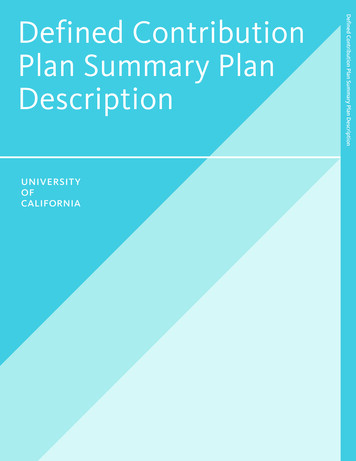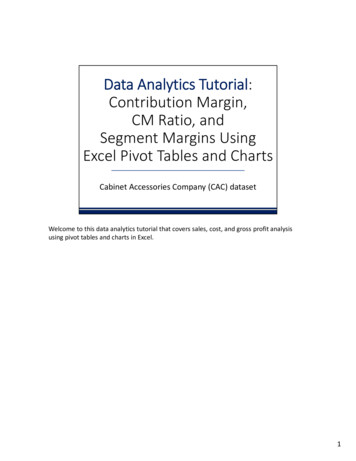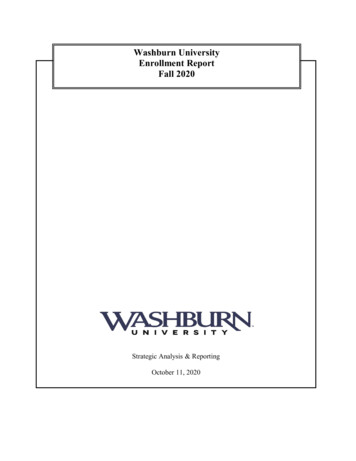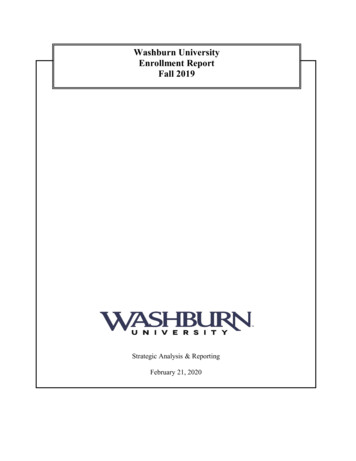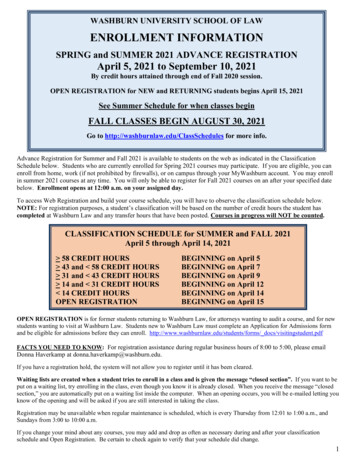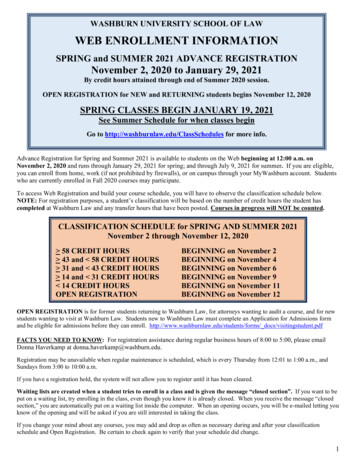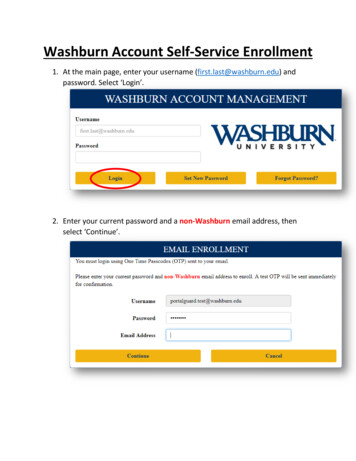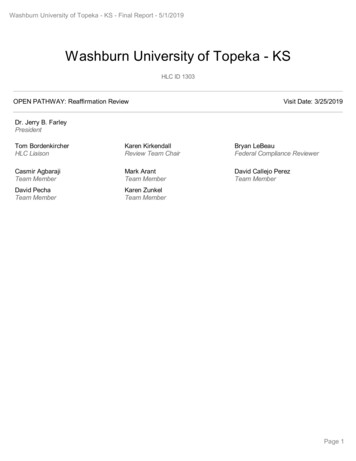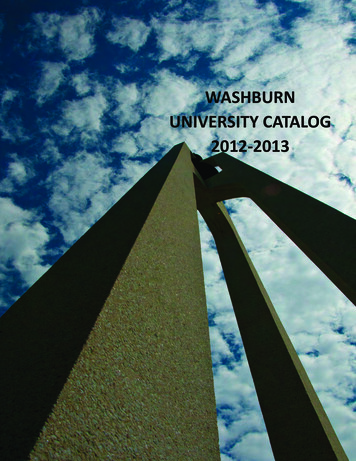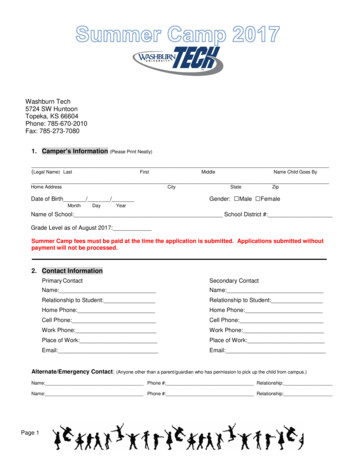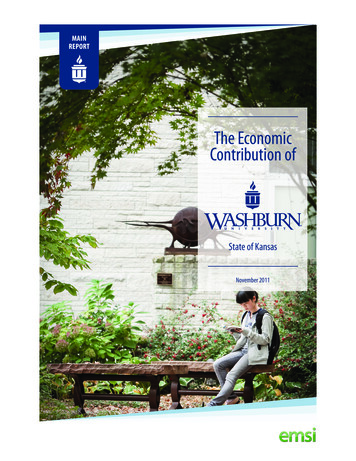
Transcription
MAINREPORTThe EconomicContribution ofState of KansasNovember 2011
CONTENTS1 INTRODUCTION1 Study overview1 Organization of the report2 CHAPTER 1: PROFILE OF WASHBURN& THE REGIONAL ECONOMY22345IntroductionUniversity profileStudent profileRegional profileConclusion6 CHAPTER 2: INVESTMENT ANALYSIS66111416IntroductionStudent perspectiveSocial perspectiveTaxpayer perspectiveConclusion17 CHAPTER 3: ECONOMIC GROWTH ANALYSIS171718192023IntroductionUniversity operations effectStudent spending effectVisitor spending effectProductivity effectConclusion24 CHAPTER 4: SENSITIVITY ANALYSIS2424252626IntroductionStudent employment variablesAlternative education variableSubstitution variableConclusion27313336394245APPENDIX 1: RESOURCES & REFERENCESAPPENDIX 2: GLOSSARY OF TERMSAPPENDIX 3: EMSI INPUT-OUTPUT MODELAPPENDIX 4: SHUTDOWN POINTAPPENDIX 5: SOCIAL EXTERNALITIESAPPENDIX 6: INVESTMENT ANALYSIS—A PRIMERAPPENDIX 7: ALTERNATIVE EDUCATION VARIABLEACKNOWLEDGMENTSEconomic Modeling Specialists Inc. (EMSI) gratefullyacknowledges the excellent support of the staff atWashburn University (Washburn) in making this studypossible. Special thanks go to Dr. Jerry Farley, President,who approved the study; and to Melodie Christal, Director of Institutional Research, Chris Leach, Director ofFinance, and Louise Williams, Institutional Researcher atWashburn Tech, who collected and organized much ofthe data and information requested. Any errors in thereport are the responsibility of the authors and not ofany of the above-mentioned institutions or individuals.
Main Report – November 2011INTRODUCTIONSTUDY OVERVIEWWashburn University (Washburn) generates a wide arrayof benefits. Students benefit from higher personal income,and society benefits from cost savings associated with reduced welfare and unemployment, improved health, andreduced crime. Education, however, requires a substantialinvestment on the part of students and taxpayers. All ofthe education stakeholders, therefore, want to know if theyare getting their money’s worth. In this study, Washburninvestigates the attractiveness of its returns as a publictraining provider relative to alternative public investments.The following two analyses are presented: 1) investmentanalysis, and 2) economic growth analysis.The investment analysis captures private and public benefits that accrue to students and taxpayers in return fortheir educational support. Private benefits include higherincome of students, while public benefits include growthin income plus an assortment of positive externalitiessuch as improved health and lifestyle habits, reducedcrime, and fewer claims for social assistance. All of theseannual benefits continue and accrue into the future for aslong as students are in the workforce. To determine thefeasibility of the investment, the model projects benefitsinto the future, discounts them back to the present, andcompares them to present costs. Results are displayedin the four following ways: 1) net present value, 2) rateof return, 3) benefit/cost ratio, and 4) payback period.The economic growth analysis focuses on the role Washburn plays in promoting economic development by increasing consumer spending and raising the skill level ofthe labor force. This in turn leads to more jobs, increasedbusiness efficiency, greater availability of public investment funds, and eased tax burdens. In general, universitylinked income falls under the following four categories:1) income generated by annual Washburn operatingEconomic Modeling Specialists Incorporatedexpenditures, 2) income generated by the spending ofWashburn students; 3) income generated by the spending of Washburn visitors; and, 4) income generated byWashburn skills embodied in the workforce.A note of importance: although the reports generated forWashburn are similar to those prepared for other educational institutions, the results differ widely. These differences, however, do not necessarily indicate thatsome institutions are doing a better job than others.Results are a reflection of location, student body profile,and other factors that have little or nothing to do withthe relative efficiency of the institutions. For this reason,comparing results between institutions or using the datato rank institutions is strongly discouraged.ORGANIZATION OF THE REPORTThis report has four chapters and seven appendices. Chapter 1 provides an overview of Washburn and the regionaleconomy. Chapter 2 presents the investment analysisresults from the students’ and taxpayers’ perspectives.Chapter 3 considers the impact of Washburn on economicgrowth in Northeast Kansas. Finally, Chapter 4 providessensitivity analyses of some of the softer variables.The appendices include a list of resources and referencesin Appendix 1, a glossary of terms in Appendix 2, a discussion of the EMSI input-output model in Appendix3, a detailed explanation of the shutdown point (an adjustment factor) in Appendix 4, an overview of the dataand assumptions used in calculating the non-economic(i.e., social) benefits of education in Appendix 5, a shortprimer on the investment analysis results in Appendix 6,and an explanation of the alternative education variablein Appendix 7.1
2The Economic Contribution of Washburn UniversityCHAPTER 1:PROFILE OF WASHBURN& THE REGIONAL ECONOMYINTRODUCTIONWashburn University is a publicly funded, independentlygoverned institution that stretches across 160 acres in theheart of Topeka, the capital of Kansas. It offers more than200 educational programs—from certificate, associate,bachelor, and master-level programs to juris doctor degreesat its School of Law—and awards more than 1,200 degreesand certificates annually. Established in 1865 as LincolnCollege and renamed Washburn University in 1868, theliberal arts institution consistently ranks as one of the bestcolleges in the Midwest by U.S. News and World Report.Washburn’s enrollment is over 8,000 credit-bearing students annually, but it has maintained small class sizes andcurrently boasts a 16:1 student-to-faculty ratio.Estimating the benefits and costs of Washburn requiresthe following three types of information: (1) the profileof the university and its student body, (2) the economicprofile of the region and the state, and (3) statistics relatingeducation to improved social behavior. For the purposes ofthis study, information on the university and its studentswas obtained from Washburn; data on the regional andstate economy were drawn from public databases; andstatistics on social behavior were provided by nationalstudies and surveys.UNIVERSITY PROFILEREVENUESTable 1.1 shows Washburn’s annual revenues by fundingsource—a total of 92.7 million in FY 2009–10. Thesedata are critical in identifying annual costs of educating the student body from the perspectives of studentsand taxpayers alike. As indicated, tuition and fees comprised 29% of total revenue, local government revenueanother 25%, revenue from state government 13%, federalWASHBURN’S NOTABLE DISTINCTIONS For the 10th consecutive year, US News and World Report ranked Washburn in its America’s Best Collegeslist. Washburn ranks seventh in the Midwest among publicmaster’s level universities. Washburn is in the top quartile (first tier) of publicand private master’s level institutions in the Midwest,ranking 36th out of 146 institutions. The Legal Analysis, Research and Writing Program atWashburn Law was ranked 13th in the US News andWorld Report 2012 law school rankings. The law librarywas also deemed one of the top 40 law libraries in thenation by The National Jurist. The School of Business has received AACSB Accreditation, an elite business school accreditation that onlythe top 5% of business schools in the world haveearned.TABLE 1.1: WASHBURN REVENUE BY SOURCE,FY 2009–10 ( THOUSANDS)SourceTotal%Tuition and fees 27,13229%Local government revenue 22,78025%State government revenue 11,65113%Federal government revenue 19,77621%All other revenue 11,34312%Total revenues 92,682100%Source: Data supplied by Washburn.Economic Modeling Specialists Incorporated
Main Report – November 2011government revenue 21%, and all other revenue (i.e., auxiliary revenue, sales and services, interest, and donations)the remaining 12%.EXPENDITURESWashburn employed 971 full- and part-time faculty andstaff and 400 student workers in the 2009–10 reportingyear. The combined payroll at Washburn amounted to 58.2 million (including student workers). Other expenditures, including capital and purchases of suppliesand services, made up 29.1 million. These budget dataappear in Table 1.2.TABLE 1.2: WASHBURN EXPENSES BY FUNCTION,FY 2009–10 ( THOUSANDS)SourceTotal% 58,24967% 7,3858%All other non-pay expenditures 21,71425%Total expenses 87,347100%Salaries, wages, and benefits(including student workers)Capital expenditures (amortized)Source: Data supplied by Washburn.FIGURE 1.1: STUDENT SETTLEMENT PATTERNSSTUDENT PROFILE100%DEMOGRAPHICS60%Washburn served 8,178 credit students in the 2009–10reporting year (unduplicated). The breakdown of thestudent body by gender was 39% male and 61% female.The breakdown of the student body by ethnicity was 81%whites and 19% minorities. The students’ overall averageage was 26.140%Figure 1.1 presents the settlement patterns of Washburnstudents. As indicated, 85% of students remain in Northeast Kansas, and 15% of students settle outside the area.ACHIEVEMENTSWashburn offers degrees and certificates through its College of Arts & Science and four distinct schools—in Applied Sciences, Business, Law, and Nursing. In addition,technical and continuing education programs, as well asbusiness and industry training, are available through theWashburn Institute of Technology, which provides 30diploma programs in the fields of building and industrial technology, business technology, design technology,electronic technology, computer repair and networking,graphics technology, health occupations, mechanical technology, and metal technology.Table 1.3 summarizes the breakdown of student achievements by degree level. As indicated, Washburn served1 Based on the number of students who reported their age,gender, and ethnicity to Washburn.Economic Modeling Specialists Incorporated85%80%15%20%0%In regionOut of regionTABLE 1.3: WASHBURN STUDENT ACHIEVEMENTSBY EDUCATION LEVEL, 2009–10HeadcountTotalCHEsAvg.CHEsJ.D. graduates1393,94528.4Master’s degree graduates1151,30111.3Bachelor’s degree graduates78514,97619.1Associate’s degree e graduatesAll other credit 9.0Source: Data supplied by Washburn.139 J.D. graduates, 115 master’s degree graduates, 785bachelor’s degree graduates, 88 associate’s degree graduates, and 123 certificate graduates in the 2009–10 reporting year. A total of 6,928 credit students comprised theremainder of the student population.In addition to the students shown in Table 1.3, Washburn3
4The Economic Contribution of Washburn UniversityREGIONAL PROFILEWASHBURN FACTS OF NOTE Washburn University Foundation has assets of approximately 153.3 million, ranking it second in Kansason a per-student basis among the public institutions. The Mayo Schmidt Finance Lab, which is located withinthe Washburn Business Technology Center, houses thetop three financial databases used by professionalson Wall Street. In the 2008 School of Business Alumni Survey, 100% ofrespondents said they would recommend the Washburn School of Business to a prospective student. Washburn Debate has finished in the top three of theOverall Squad Sweepstakes for the last five years at theNational Parliamentary Debate Association Championships. The team was NPDA Squad Champion in 2010. Each year, 1,000 Washburn students participate ininternship opportunities at more than 125 sites inWashburn’s capital city location. Learning in the Community (LinC) enhanced the uni-Since Washburn first opened its doors to students in 1865,the university has been serving the local community bycreating jobs and income, providing area residents witheasy access to higher education opportunities, and preparing students for highly-skilled, technical professions. Theavailability of quality education and training in NortheastKansas also attracts new industry to the region, therebygenerating new businesses and expanding the availabilityof public investment funds.Table 1.4 summarizes the breakdown of the NortheastKansas economy by major industrial sector, with detailson labor and non-labor income. Labor income refers towages, salaries, and proprietors’ income; while non-laborincome refers to profits, rents, and other income. Together,labor and non-labor income comprise a region’s total grossregional product, or GRP.2As shown in Table 1.4, Northeast Kansas’s GRP is approximately 63.8 billion, equal to the sum of labor income( 42.7 billion) and non-labor income ( 21.1 billion).In Chapter 3, we use Northeast Kansas’s gross regionalproduct as the backdrop against which we measure theversity’s partnerships in the city by providing readingand math literacy tutoring to children and adults ateight locations through the Literacy Education Action Project. Forty-five Washburn students providedMarshallNemahaBrownassistance to 442 learners.Atchison Eighty-three percent of Washburn full-time facultymembers hold doctorates or the highest degree intheir discipline.RileyPottawatomieJacksonShawneealso served 114 personal enrichment students enrolled inthe university’s 65-and-over tuition-free audit program.In the analysis, we exclude the credit production of thesestudents under the assumption that they do not attainworkforce skills that will increase their earnings.DoniphanGearyWabaunseeJefferson Leavenworth WyandotteDouglasJohnsonOsageFranklinMiamiWASHBURN UNIVERSITYSERVICE AREAAltogether, Washburn students completed 155,735 credithour equivalents (or CHEs) during the 2009–10 reportingyear. The average number of CHEs per student was 19.0.2 See the glossary of terms in Appendix 2 for a full definitionof GRP.Economic Modeling Specialists Incorporated
Main Report – November 2011TABLE 1.4: LABOR AND NON-LABOR INCOME BYMAJOR INDUSTRIAL SECTOR IN NORTHEAST KANSAS, 2010 ( MILLIONS)*Labor incomeNon-laborincomeTotal incomeAgriculture, forestry, fishing and hunting 466 223 6891%Mining 229 192 421 1%Utilities 353 978 1,3312%Industry Sector% of totalConstruction 2,137 244 2,3814%Manufacturing 3,643 2,300 5,9439%Wholesale trade 2,722 2,038 4,7607%Retail trade 2,281 1,274 3,5566%Transportation and warehousing 1,771 502 2,2734%Information 1,712 3,216 4,9288%Finance and insurance 3,474 2,915 6,38910% 763 2,787 3,5496% 3,815 724 4,5397% 961 153 1,1142% 1,770 318 2,0883%Real estate and rental and leasingProfessional and technical servicesManagement of companies and enterprisesAdministrative and waste servicesEducational servicesHealth care and social assistance 389 48 437 1% 4,338 418 4,7567%Arts, entertainment, and recreation 188 55 243 1%Accommodation and food services 967 465 1,4322%Other services, except public administration 1,138 137 1,2742%Federal government 4,099 1,566 5,6659%State and local government 5,483 536 6,0209% 42,699 21,090 63,789100%Total* Data reflect the most recent year for which data are available. EMSI data are updated quarterly.† Numbers may not add due to rounding.Source: EMSI.relative impacts of the university on economic growthin the region.CONCLUSIONThis chapter presents the broader elements of the databaseused to determine the results. Additional detail on dataEconomic Modeling Specialists Incorporatedsources, assumptions, and general methods underlyingthe analyses are conveyed in the remaining chapters andappendices. The core of the findings is presented in thenext two chapters—Chapter 2 looks at Washburn as aninvestment, while Chapter 3 considers Washburn’s rolein economic growth. The appendices detail a collectionof miscellaneous theory and data issues.5
6The Economic Contribution of Washburn UniversityCHAPTER 2:INVESTMENT ANALYSISINTRODUCTIONFIGURE 2.1: AVERAGE INCOMEAT CAREER MIDPOINTInvestment analysis is the process of evaluating total costsand measuring these against total benefits to determinewhether or not a proposed venture will be profitable. Ifbenefits outweigh costs, then the investment is worthwhile. If costs outweigh benefits, then the investment willlose money and is thus considered infeasible.In this chapter, we consider Washburn as an investmentfrom the perspectives of students and taxpayers, the majorstakeholders. The backdrop for the analysis is the entirestate of Kansas. 113,470 78,900 65,400 45,600 33,700 21,700 HSSTUDENT PERSPECTIVEAnalyzing the benefits and costs of education from theperspective of students is the most obvious—they giveup time and money to go to the university in return fora lifetime of higher income. The benefit component ofthe analysis thus focuses on the extent to which studentincomes increase as a result of their education, while costscomprise the monies they put up.LINKING EDUCATION TO EARNINGSThe correlation between education and earnings is welldocumented and forms the basis for determining the benefits of education. As shown in Table 2.1, mean incomelevels at the midpoint of the average-aged worker’s careerincrease for individuals who have attained higher levelsof education. These numbers are derived from EMSI’sindustry data on average income per worker in NortheastKansas,3 broken out by gender, ethnicity, and educationlevel using data supplied by the U.S. Census Bureau.HSAssociate's Bachelor's Master's DoctorateTABLE 2.1: EXPECTED INCOME IN NORTHEASTKANSAS AT MIDPOINT OF INDIVIDUAL’SWORKING CAREER BY EDUCATION LEVELEducation levelIncomeDifferenceLess than high school 21,700n/aHigh school or equivalent 33,700 12,000Associate’s degree 45,600 11,900Bachelor’s degree 65,400 19,800Master’s degree 78,900 13,500 113,470 34,570Professional/doctoral degreeSource: Derived from data supplied by EMSI industry data andthe U.S. Census Bureau. Figures are adjusted to reflect averageearnings per worker in Northeast Kansas.The differences between income levels define the marginalvalue of moving from one education level to the next. Forexample, students who move from a high school diplomatypically included in state data, as well as benefits and all forms3 It is important to note that wage rates in the EMSI modelof employer contributions. As such, EMSI industry earnings-combine state and federal sources to provide earnings thatper-worker numbers are generally higher than those reportedreflect proprietors, self-employed workers, and others notby other sources.Economic Modeling Specialists Incorporated
Main Report – November 2011to a bachelor’s degree may expect approximately 31,700in higher annual income. The difference between a highschool diploma and the attainment of a master’s degreeis even greater—up to 45,200 in higher income.Of course, several other factors such as ability, socioeconomic status, and family background also positively correlate with higher earnings. Failure to account for thesefactors results in what is known as an “ability bias.” Aliterature review by Chris Molitor and Duane Leigh indicates that the upper limit benefits defined by correlationshould be discounted by 10%.4 As such, we adjust thegross increase in income downward by 10%.DETERMINING THE VALUE PER CHENot all students who attended Washburn in the 2009–10reporting year obtained a degree or certificate in the courseof the year. Some may have returned the following yearto complete their education goals, while others may havetaken a few courses and entered the workforce withoutachieving a credential. As such, the only way to measurethe value of the students’ achievement is through theircredit hour equivalents, or CHEs. This allows us to seethe benefits to all students, not just to those who earnan award.In the model, we calculate the value of the students’ CHEproduction through a complex proc
Washburn University (Washburn) generates a wide array of benefits. Students benefit from higher personal income, and society benefits from cost savings associated with re-duced welfare and unemployment, improved health, and reduced crime. Education, however, requires a substantial
